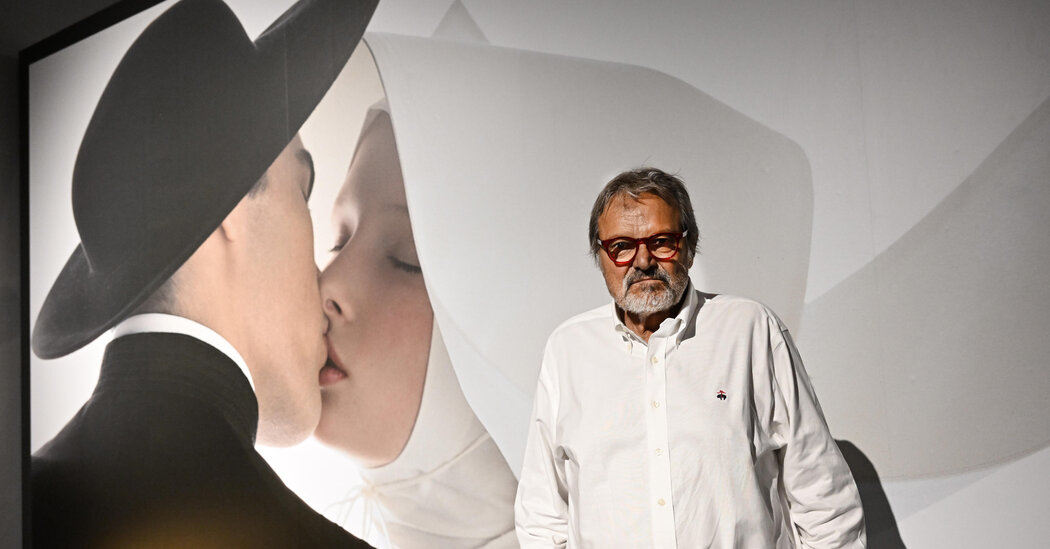
Oliviero Toscani, an Italian photographer who used images of an AIDS patient and death row inmates to break the boundaries of fashion imagery as the creative mastermind of Benetton’s advertising campaigns, died on Monday. He was 82 years old.
His death was announced by his family on Instagram. They did not say where he died or cite the cause of death, but in August Mr. Toscani told the Italian newspaper Corriere della Sera that he had been diagnosed with amyloidosis, a rare and incurable condition in which a buildup of proteins occurs.
His shocking campaigns in the 1980s and 1990s helped transform Benetton from a small Italian brand into a global fashion powerhouse, with provocative ads that blurred the lines between marketing and activism, high art and consumer industry.
In one ad, an AIDS patient lay on his back, with his mouth open and his hands folded on his chest. His dark eyes looked beyond his family, who had gathered around his deathbed. The patient, David Kirby, looked almost Christ-like.
And there, almost at the bottom right, some words were hung in a green box: “United Colors of Benetton”.
The advert, published in the 1990s, was one of the most provocative and controversial in recent fashion history, sparking furious debates over whether Benetton and Toscani were creating art, engaging in advocacy or exploiting the epidemic to sell their clothes.
Notably, Toscani had permission from the Kirby family to use a colorized version of the image, taken in 1990 by photographer Therese Frare. The Kirbys said the campaign helped raise awareness about AIDS.
“Benetton did not use us, nor did he exploit us,” the Kirby family said, arguing that this was a way for their son’s portrait to be “seen around the world, and that’s exactly what David wanted.”
Toscani’s ads were often socially progressive, featuring images of gay and racially diverse families. They also had to shock. He used images of horses mating. He used the blood-stained uniform of a soldier killed in Bosnia-Herzegovina. One commercial showed actors dressed as priests and nuns kissing.
“Ad agencies make millions doing the same old thing,” he told the New York Times in 1995, adding, “Let’s try to go another route.”
Mr. Toscani sometimes crossed the line even for Benetton. He joined the company in 1982 and left in 2000 amid uproar over an advertising campaign featuring photographs of death row inmates in the United States.
He returned as creative director in 2017. But his career at Benetton ended in 2020, not because of the calculated and audacious risks he had taken in photography and advertising, where he reveled in his radical challenges to conventional ideas of respectability . Rather, it was because of an offhand comment he made in a radio interview about a bridge collapse in Italy that killed more than 40 people. “Who cares if a bridge collapsed?” he had said. Although he apologized, Benneton fired him.
Italian politicians and creative leaders honored him in social media tributes on Monday. Fashion designer Valentino Garavani, the creator of Valentino, called him “a visionary who challenged the world through his lens.” Fashion designer Giorgio Armani wrote that “the immediacy and visual impact of his language set a standard”.
Oliviero Toscani was born in Milan on 28 February 1942. He followed in the footsteps of his father, Fedele Toscani, a photojournalist. Toscani trained at the Zurich School of Applied Arts and worked as a stylist before joining the Benetton Group as artistic director in 1982.
His survivors include his wife, Kirsti Moseng Toscani, and their three children, Rocco, Lola and Ali. Mr. Toscani married twice previously and had three other children. Complete information on survivors was not immediately available.
In his final months, Mr. Toscani told Corriere della Sera that he lost weight while being treated for amyloidosis and that his sense of taste had diminished. The wine tasted different to him, he said. “I’m not interested in living like this,” he added.
But in September he went to the Museum fur Gestaltung in Zurich for a major retrospective of his work entitled “Oliviero Toscani: photography and provocation”. It closed just over a week before his death.
“I’ve found that advertising is the richest and most powerful medium that exists today,” he told the Times in 1991. “So I feel a responsibility to do more than say, ‘Our sweater is cute.’”
Elisabetta Povoledo AND Matthew Mpoke Bigg contributed to the reporting.
